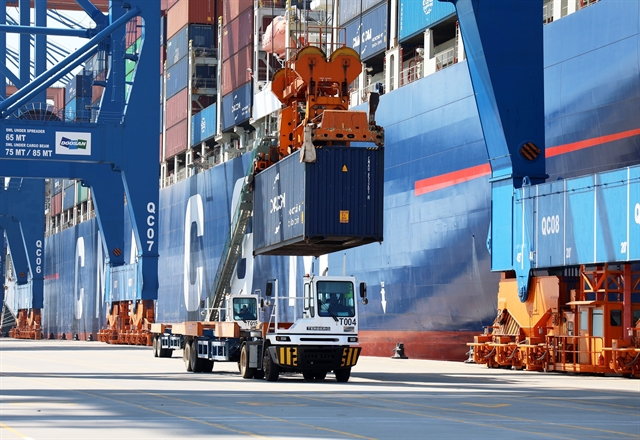 Business Beat
Business Beat

 |
| Võ Trí Thành |
*Võ Trí Thành
Việt Nam has experienced a noteworthy economic performance in the first half of 2024, surpassing initial expectations. This success has led the government to revise its GDP growth target upwards to a range of 6.5 per cent to 7 per cent for the year. However, while macroeconomic indicators are promising, the mood among domestic businesses remains cautious, reflecting ongoing challenges that are not immediately visible in the broader economic data.
Economic performance: a closer look
According to the General Statistics Office (GSO), Việt Nam's economy expanded by 6.42 per cent in the first half of 2024. This impressive growth has been fuelled by strong export performance, robust foreign direct investment (FDI) and increased consumption. The Central Institute for Economic Management (CIEM) responded to this positive trend by revising its growth forecast for the year from 6.48 per cent to 6.95 per cent. This adjustment is underpinned by a global economic recovery, which has buoyed Việt Nam's economic prospects.
Despite these positive figures, the reality on the ground for many businesses tells a somewhat different story. The business environment remains challenging, as evidenced by the close numbers of business registrations and closures.
In the first seven months of 2024, Việt Nam registered over 95,200 new businesses, representing a 6.3 per cent increase compared to the same period last year. Including businesses that have resumed operations, the total number of active enterprises reached nearly 139,500, up 5.8 per cent year-on-year, with an average of more than 19,900 businesses per month.
However, this growth is juxtaposed with significant difficulties. More than 78,000 businesses temporarily ceased operations, marking a 16.7 per cent increase. Additionally, 35,500 businesses suspended operations pending dissolution (a decrease of 1.5 per cent), and 11,900 businesses completed dissolution (an increase of 14.5 per cent). Consequently, more than 17,900 businesses exited the market each month.
Key drivers of GDP growth
A closer examination of the factors driving GDP growth reveals that recent economic performance is heavily influenced by external factors rather than domestic business activity:
The first was export performance. Việt Nam's foreign trade has been a major contributor to economic growth.
 |
| Containers at Gemalink Port in Bà Rịa-Vũng Tàu Province.Việt Nam's foreign trade has been a major contributor to economic growth. VNA/VNS Photo Hồng Đạt |
During the first seven months of 2024, the country’s total foreign trade approached US$440 billion, reflecting a 17 per cent increase year-on-year. Export revenue reached nearly $227 billion, up 15.7 per cent, while imports rose by 18.5 per cent to $213 billion. This resulted in a trade surplus of $14.08 billion.
Within this, the domestic economic sector contributed $63.08 billion, accounting for 27.8 per cent of the total export turnover and reflecting a 21.1 per cent increase. In contrast, the foreign-invested sector, including crude oil, contributed $163.9 billion, representing 72.2 per cent of total exports and a 13.8 per cent increase. Besides the strong performance in agricultural, forestry and seafood exports, the recovery in the processing and manufacturing sector, which is dominated by FDI enterprises, accounted for 72-75 per cent of the sector’s growth.
The second driver was investment, mainly foreign direct investment (FDI).
In the first seven months of 2024, total FDI in Việt Nam amounted to over $18 billion, a 10.9 per cent increase from the previous year. Realised FDI capital reached $12.55 billion, up 8.4 per cent, marking the highest level in five years. However, private sector investment remains modest, rising by only 5-6 per cent, compared to over 2 per cent last year and falling short of the pre-pandemic average of 10 per cent.
 |
| FDI inflow in Việt Nam in the past seven months. — VNA Infographic |
State investment has also lagged behind due to slow public investment disbursement. According to the Ministry of Finance, public investment disbursement from the beginning of the year until July 31 totalled VNĐ232.1 trillion, reaching 32.22 per cent of the total plan and 34.68 per cent of the plan assigned by the Prime Minister. This figure indicates a slowdown compared to the same period in 2023, when disbursement rates were 35.49 per cent of the total plan and 37.85 per cent of the plan assigned by the Prime Minister.
The third pillar was consumption.
In 2023, consumption grew robustly, contributing significantly to economic development with a growth rate of nearly 10 per cent. Retail growth in the first half of 2024 remained above 8 per cent, though this represents a decline from the 11.3 per cent growth observed in the previous year.
This decrease suggests that domestic consumers are tightening their budgets, even as retail sales figures are buoyed by international tourism. Retail sales of goods and consumer services increased by 8.7 per cent in the first seven months of 2024, compared to a 10.6 per cent increase last year. When adjusted for price factors, the increase is 5.2 per cent, compared to 9.8 per cent in the same period of 2023.
International arrivals to Việt Nam reached nearly 10 million, a 51 per cent increase from the previous year and a 1.9 per cent increase from the pre-pandemic period of 2019.
 |
| Foreign tourists explore HCM City on cyclo rides. — VNA/VNS |
The disparity between macroeconomic indicators and the experience of domestic businesses highlights ongoing challenges.
Many businesses report difficulties related to decreased orders, challenging sales conditions, high raw material costs, recent electricity price increases, and limited access to capital. These issues are particularly affecting small and medium-sized enterprises (SMEs) in the manufacturing sector.
The Việt Nam Association of Small and Medium Enterprises has highlighted these challenges, noting that the business environment remains tough despite the overall economic growth. The real estate market has not recovered as expected and credit growth remains low. The issues faced by SMEs are compounded by a complex regulatory environment and persistent economic uncertainties.
To support domestic businesses and stimulate economic activity, the government is implementing a range of policies. These include continued adjustments to fiscal and monetary policies, enhanced public investment disbursement and various tax reductions. Notably, a two per cent VAT reduction has been proposed until the end of 2024, along with extensions for land use fees and land lease payments. Efforts to maintain low lending interest rates are also underway.
In the tourism sector, Việt Nam is considering the adoption of a Southeast Asia common visa initiative. Proposed by Thailand, this initiative involves six ASEAN countries — Cambodia, Malaysia, Myanmar, Laos, Thailand and Việt Nam — and aims to simplify visa regulations and facilitate travel within the region. Such measures could help boost tourism and contribute to overall economic growth.
Furthermore, attracting high-quality FDI remains crucial for enhancing linkages and encouraging Vietnamese enterprises to participate in international supply chains. By increasing competitiveness and fostering integration into global markets, high-quality FDI can play a key role in sustaining economic growth and addressing domestic business challenges.
While Việt Nam’s economic performance in 2024 is marked by strong growth in exports, investment and consumption, domestic businesses face significant hurdles. The government’s efforts to stimulate economic activity and support businesses will be essential in addressing these challenges and ensuring continued economic progress.
*Võ Trí Thành is former vice-president at the Central Institute for Economic Management (CIEM) and a member of the National Financial and Monetary Policy Advisory Council. With a doctorate in economics from the Australian National University, Thành mainly undertakes research and provides consultation on issues related to macroeconomic policies, trade liberalisation and international economic integration. Other areas of interest include institutional reforms, financial systems and economics of development. He authors the Việt Nam News column Analyst’s Pick.